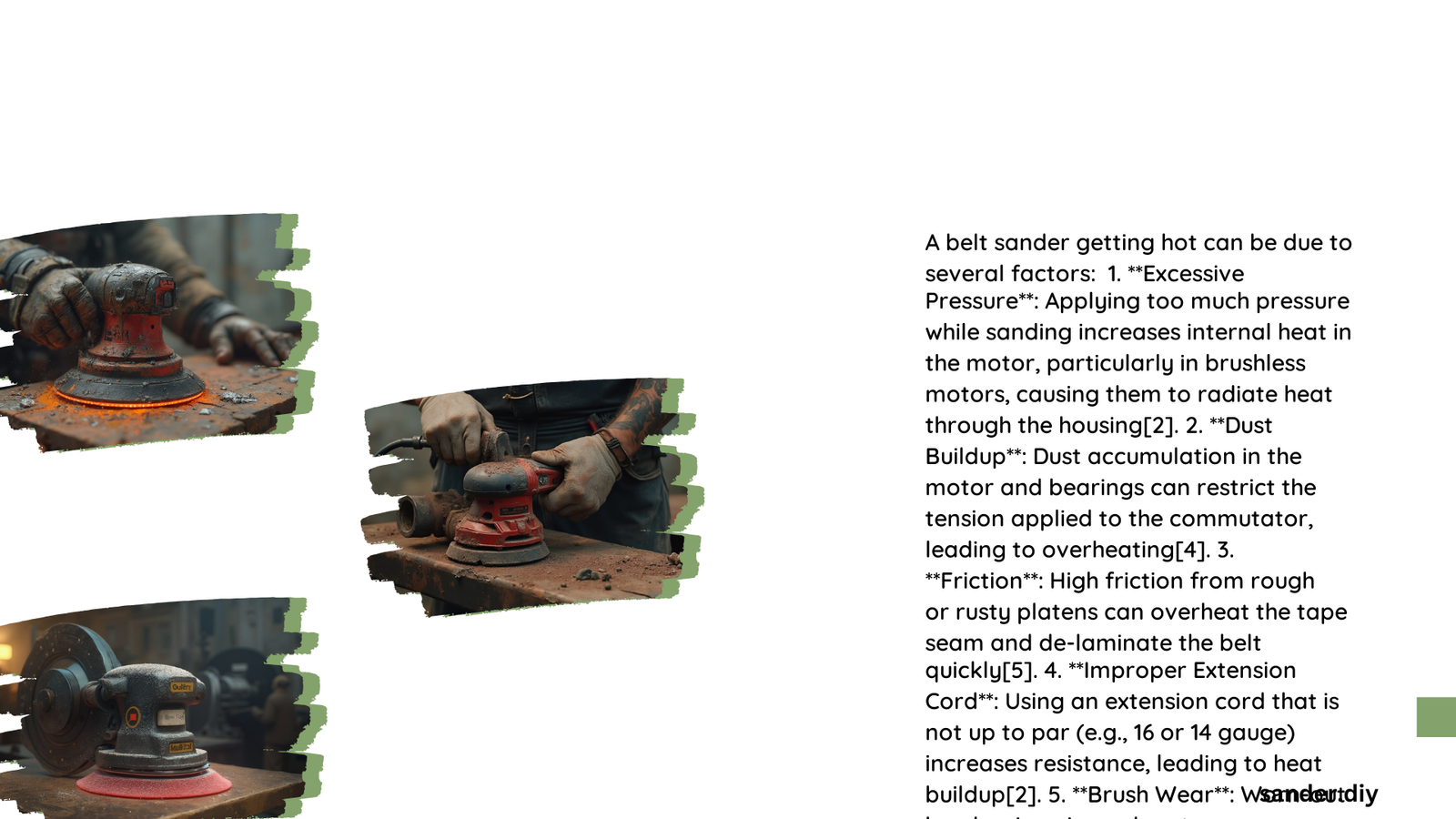Belt sanders are essential tools for woodworking and metalworking, but they can often become hot during use. This heat generation is a common issue that can affect the tool’s performance and lifespan. Understanding the causes of a belt sander getting hot, implementing effective cooling methods, and following best practices for heat management are crucial for maintaining the tool’s efficiency and safety. This article explores the primary reasons for heat buildup in belt sanders, provides solutions to prevent overheating, and offers guidance on optimal operating conditions.
Why Does My Belt Sander Get Hot?
Belt sanders can generate heat due to various factors, including motor specifications, friction, material interactions, and airflow issues. The primary causes of heat buildup include:
- Excessive downward pressure on the tool
- Friction from the sanding action
- Type of material being sanded
- Poor airflow or faulty dust extraction
- Improper extension cord use
What Are the Primary Causes of Heat Generation in Belt Sanders?
Motor Specifications and Pressure
- Excessive downward pressure can increase internal heat in the brushless motor
- Heat radiates through the composite or grip housing
Friction Factors
- Constant rubbing of surfaces during sanding generates heat and static electricity
- Dust and debris production contributes to friction
Material Interactions
- Soft woods like pine with higher resin content lead to more loading and heat buildup
- Resin or glue on the workpiece can melt onto the belt, causing loading and burning issues
Airflow and Dust Extraction
- Poor airflow or faulty dust extraction systems contribute to dust buildup
- Dust accumulation increases heat generation and static electricity issues
Extension Cords and Electrical Issues
- Using improper extension cords can increase resistance and lead to heat buildup
How Can I Cool Down My Belt Sander?

To prevent overheating and reduce motor temperature, consider the following cooling methods:
- Proper use of vacuum and vent covers
- Regular maintenance
- Grounding the sander
- Correct belt tension and alignment
What Are Effective Cooling Methods for Belt Sanders?
Proper Use of Vacuum and Vent Covers
- Remove gray rubber side vent covers when not using a vacuum
- Increased airflow helps maintain normal operating temperatures
Regular Maintenance
- Blow out the tool body with compressed air regularly
- Prevent dust buildup in the motor and bearings
Grounding the Sander
- Connect the machine to the earth using a grounding rod
- Dissipates static charge and reduces dust buildup
Correct Belt Tension and Alignment
- Ensure proper tension pressure for different belt types:
- 45-55 psi for paper belts
- 55-65 psi for cloth belts
- Maintain proper alignment between sanding unit and feed system
What Are the Optimal Operating Temperatures for Belt Sanders?
While specific temperature ranges are not universally defined, it’s important to note that:
- Power tools naturally become warm during use
- Excessive heat indicates a problem
- Maintaining basic care is crucial to prevent overheating
How Do Different Materials Impact Operating Temperatures?
| Material Type | Temperature Impact |
|---|---|
| Soft Woods | Higher temperatures due to increased loading |
| High Resin Content | More heat buildup on the belt |
| Hard Woods | Generally lower temperatures |
| Metals | Can generate more heat, requires appropriate belts |
What Are the Best Practices for Heat Management in Belt Sanders?
To effectively manage heat in belt sanders, consider the following best practices:
- Implement regular maintenance schedules
- Use proper monitoring techniques
- Make specific adjustments for optimal performance
How Can I Implement Effective Maintenance Schedules?
- Clean the tool regularly with compressed air
- Schedule periodic checks for dust buildup in motor and bearings
- Inspect belts for wear and replace as needed
What Monitoring Techniques Should I Use?
- Pay attention to excessive heat during operation
- Utilize built-in shutoff features if the tool overheats
- Allow sufficient cooling time before restarting an overheated sander
What Specific Adjustments Can Improve Heat Management?
- Ensure proper airflow:
- Remove vent covers when not using a vacuum
-
Use correct extension cords to avoid electrical resistance
-
Vary the entry point on the machine:
- Prevents loading and burning issues on the belt
-
Distributes wear more evenly
-
Inspect workpieces:
- Check for resin or glue buildup
- Ensure consistent quality of materials being sanded
By understanding the causes of belt sanders getting hot and implementing these best practices, you can significantly improve the performance and longevity of your tool while ensuring safe and efficient operation.
References:
1. SurfPrep: Why is my tool getting hot?
2. Sandpaper.com: Top 8 Wide Belt Sanding Problems & How To Solve Them #5-8
3. Fintech Abrasives: Common Wide Belt Sander Issues & Solutions
